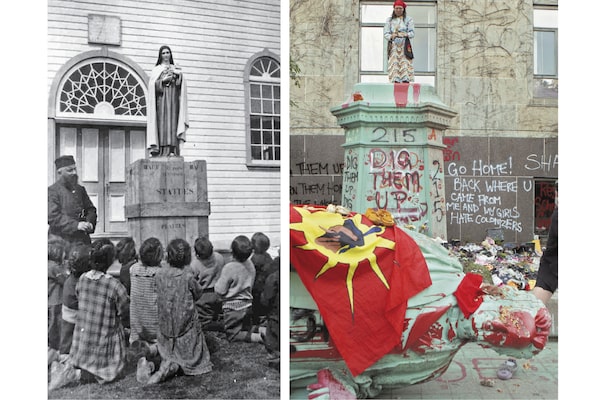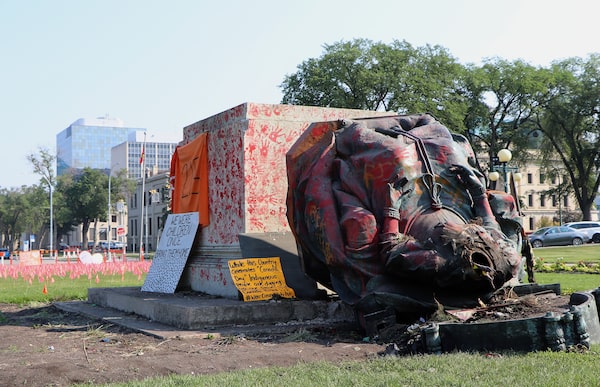
LEFT: Children pray to a newly arrived French statue of Ste. Therese de l’Enfant Jesus at Holy Angels Residential School in Fort Chipewyan, Alta., in June, 1931. The school was operated by the Roman Catholic orders of the Grey Nuns and Oblates. RIGHT: A protester stands on the pedestal of a statue of Egerton Ryerson at Toronto’s Ryerson University after protesters pulled it down in June, 2021. The school was recently renamed Toronto Metropolitan University.University of Saskatchewan Archives/The Canadian Press
Gail Lord is a museum planner and the president and co-founder of Lord Cultural Resources. She was the consultant for the establishment of both the Canadian Museum for Human Rights (CMHR) and the National (Smithsonian) African American Museum of History and Culture.
At the University of Ghana, the administration in 2018 removed the statue of famed Indian independence leader Mahatma Gandhi in response to a petition that claimed he was racist.
In 2020, during anti-racism protests in Bristol, a slave trader’s statue was torn down and thrown into the harbour.
Mexico City confirmed last fall that a figure of an Indigenous woman will replace the capital’s Christopher Columbus monument.
Ideas about history are constantly in flux. In recent years, people everywhere have been critically rethinking representations of the past from a perspective of social justice and anti-colonialism. And as part of this collective reflection, communities, cities and countries are reassessing what, how and who they publicly honour and celebrate with the statues featured in their public spaces.
Canada is no exception: Last year, anger at the deaths of Indigenous children at residential schools led crowds in Winnipeg to topple a Queen Victoria statue and another of Queen Elizabeth II.
Earlier this year, Ryerson University was renamed Toronto Metropolitan University after years of advocacy, consultation and committee work, as well as protests that defaced and toppled his statue, ultimately throwing it into Toronto Harbour. (Ryerson, a supporter of public education, was a high-profile advocate of the residential-school policy, which separated more than 150,000 Indigenous children from their families – producing suffering for generations.)
But what happens next to these statues of fallen historical figures is a logistical, financial and educational question that cities and communities are struggling with. In New Orleans, four Confederate monuments have now been in storage for more than a year after they were taken down. Similarly, Baltimore keeps four monuments in a secret location while a city task force decides what to do with them.
But for Canada, this question of what cities should do with statues they no longer want represents a unique opportunity to lead in the creation of a new type of public institution – one that offers both a practical solution and addresses the complexity of our changing understanding of the past and its impact on the present.
This describes neither a museum nor a warehouse, but a proposal that I call an “aware-house.” Such a space would display fallen statues to build understanding about historical processes, including how and why they were first erected and how they came to be removed. Appreciating its potential positive impact as both a learning and healing experience requires looking at the current discourse on this issue.
Once a statue is taken down, whether by crowds or by design, what happens next isn’t clear. Storage is expensive, and once a figure ends up there, it’s unlikely to be brought back up again – removing the opportunity to have that educational conversation or use the moment to foster public engagement.
“Just send them to a museum” is a common misconception in this discussion. The mission of museums is not to be the attic for the nation’s unwanted items. Other alternatives, such as the case made by sociology professor Gary Younge to stop creating any monuments featuring historical figures, could be a go-forward option, but it doesn’t address what to physically do with those that are removed.
Countries such as Russia and the former Yugoslavia created “gardens of fallen statues,” but these are limited in their scope serving primarily as places of nostalgia rather than education or community healing.
The aware-house, meanwhile, would create a public place that starts with the recognition that history is a living discipline. Imagine a towering space, such as an aircraft hangar, filled with monuments and statues from our past. The foundation of the conversation they are driving starts with the framework that history and norms are ever changing, and then looks to explore what it means with perspectives from across sectors, backgrounds and life experiences. A swipe of a QR code empowers users to engage in a multimedia and immersive metaverse experience.
Equally important, the process of designing the aware-house is part of the healing journey of wronged communities and involves engaging new and diverse stakeholders in discussions, not only with historians of different viewpoints, but sociologists, poets, artists, psychologists and policy makers. Exhibitions on different themes could be shared around the country and adapted to local stories as needed to continue dialogue around the issues that these statues surface – including their long-term impact on public and social problems today.
Just as Canada in 2014 established the CMHR, the world’s first national museum dedicated to human rights, we could now lead the way on a new global chapter: pro-actively addressing the interplay between legacy racism, sexism, colonial exploitation and contemporary institutional and systemic challenges.
And as the country reflects on Pope Francis’s recent apology tour, it’s the perfect time to launch an aware-house – which, by curating and contextualizing removed relics to create genuine awareness and understanding for the future, could become an anchor component of our national reconciliation efforts.

A headless statue of Queen Victoria is seen overturned and vandalized at the provincial legislature in Winnipeg on July 2, 2021.Kelly Geraldine Malone/The Canadian Press
Keep your Opinions sharp and informed. Get the Opinion newsletter. Sign up today.